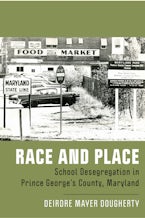Race and Place considers the everyday experiences of community members throughout the process of school desegregation and how race, place, and truth came to matter in this process in Prince George’s County, Maryland, from 1945 through 1973. The book is organized around several successive policies that emerged in this time: school equalization, school choice, neighborhood schools, school construction, school closure, busing for racial integration, and school discipline. Dougherty shows how these policies contained and reinforced assumptions about place and created new racial truths about people and schooling.
Contents
Introduction: Race, Place, and Truth
Part I: Spectral Spaces: Schooling Pre-Brown 1632-1950
1 “The Party of Memory and the Party of Hope”: Contradiction in Black and White
2: Public Schooling in Maryland before Brown
Part II: A Policy of Nostalgia (1954-1968)
3: Thomas Pullen and Gradual Adjustment
4: William Schmidt and The Freedom of Unequal Choices, 1960-1968
Part III: Mythologizing the Neighborhood
5: White Suburbanization and School Construction in Belair at Bowie, 1920-1965
6: Black Suburbanization: School Closure and Urban Renewal in Fairmount Heights, 1920-1968
Part IV: Moralizing Space and Race
7: The Moral Geography of Busing, 1972
8: Discipline, Danger, and Desegregation, 1973
Conclusion: “…cleaner, whiter, richer, safer than where you are”
Acknowledgments
Notes
Bibliography
Index
Introduction: Race, Place, and Truth 1
Part I Spectral Spaces: Schooling Pre-Brown
(1632–1950)
1 “The Party of Memory and the Party of Hope”:
Contradiction in Black and White 21
2 Public Schooling in Maryland
before Brown 28
Part II A Policy of Nostalgia (1954–1968)
3 Thomas Pullen and Gradual Adjustment 45
4 William Schmidt and the Freedom of Unequal
Choices, 1960–1968 58
Part III Mythologizing the Neighborhood
5 White Suburbanization and School Construction in Belair
at Bowie, 1920–1965 71
6 Black Suburbanization: School Closure and Urban Renewal
in Fairmount Heights, 1920–1968 92
Part IV Moralizing Space and Race
7 The Moral Geography of Busing, 1972 119
8 Discipline, Danger, and Desegregation, 1973 132
Conclusion: “. . . cleaner, whiter, richer, safer than where you are” 146
Acknowledgments
151
Notes 155
Index 000

